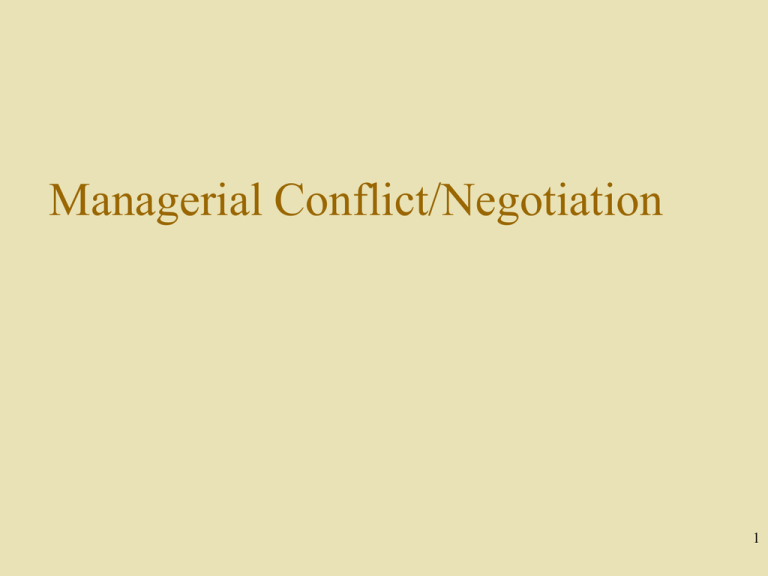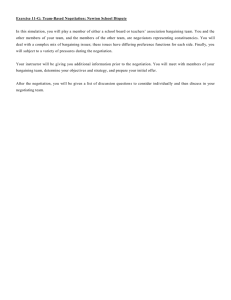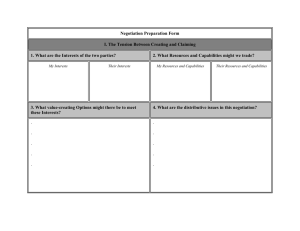Managerial Conflict/Negotiation 1
advertisement

Managerial Conflict/Negotiation 1 What is conflict? Conflict occurs whenever: – Disagreements exist over important subjects. – Emotional conflicts cause frictions between individuals or groups. 2 Types of conflict Task Conflict Conflicts over content and goals of the work. Relationship Conflict Conflict based on interpersonal relationships. Process Conflict Conflict over how work gets done. 3 Stages of conflict. – Conflict antecedents . • Set the conditions for conflict. – Perceived conflict. • emotional differences are sensed. – Felt conflict. • Tension creates motivation to act. – Manifest conflict. • Conflict resolution or suppression. 4 Causes of conflict. – Vertical conflict. • Occurs between hierarchical levels. – Horizontal conflict. • Occurs between persons or groups at the same hierarchical level. – Line-staff conflict. • Involves disagreements over who has authority and control over specific matters. 5 How can conflict be managed successfully? Conflict resolution. – A situation in which the reasons for a destructive conflict are eliminated. 6 Outcomes from Conflict – Increased group performance – Improved quality of decisions – Stimulation of creativity and innovation – Encouragement of interest and curiosity – Provision of a medium for problem-solving – Creation of an environment for self-evaluation and change 7 What is negotiation? Negotiation. – is a dialogue between two or more people or parties. – The process of making joint decisions when the parties involved have different preferences. – Workplace disagreements arise over a variety of matters. 8 Objectives of negotiation Resolve disagreement between parties and improve working relationships. Improve cooperation Effective negotiation is characterized by: • Quality. • Harmony. • Efficiency. 9 When do we need to negotiate? Levels – Between individuals – Inter-team negotiation – Intra-team negotiation 10 Negotiation process negotiations involves several steps including: preparation, building the relationship, persuasion, making concessions and reaching agreement 11 What is negotiation? Culture and negotiation. – Differences in negotiation approaches and practices are influenced by cultural differences in: • Time orientation. • Individualism-collectivism. • Power distance. 12 Negotiator characteristics Tolerance Transparency Flexibility and creativity Humor power Curiosity 13 Negotiation strategies Strategy of “winner–loser” (win-lose): - the objective is to negotiate the solution that tends to make one party or another. -Search for possible win-lose situations “Problem solving” strategy: Definition of the problem and try to diagnose their causes and the search for alternatives to the appropriate solutions for parties to the conflict. 14 What are the different strategies involved in negotiation? Third-party roles in negotiation. – Arbitration. • A third party acts as a “judge” and has the power to issue a decision that is binding on all disputing parties. – Mediation. • A neutral third party tries to engage the disputing parties in a negotiated solution through persuasion and rational argument. 15




